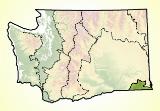 © Pete Saloutos/Panoramic Images (Washington Title Image Large)
© Pete Saloutos/Panoramic Images (Washington Title Image Large)

Blue Mountains Human Impact
Ongoing challenges to the native biodiversity and ecological integrity of the Blue Mountains include:
- Changes in fire regime. Past forest practices and a century of fire suppression have substantially altered function and composition of the ecoregion’s ponderosa pine and Douglas-fir forests. The loss of mature stands reduce habitat for cavity nesters, such as the pygmy nuthatch and flammulated owl. Overstocked forests of smaller trees increase the danger of large-scale fires.
- Excessive grazing. Overgrazing of the ecoregion’s grasslands has changed the plant composition dramatically and allowed invasive cheatgrass to gain a hold.
- Agricultural conversion. Nearly all the remaining interior grasslands have been converted to dryland wheat, irrigated field crops, or hay and alfalfa. Many of the ecoregion’s low-lying wetlands, home to the Columbia spotted frog, have been drained for agricultural uses.
Despite these impacts, natural or semi-natural vegetation is dominant in Washington's Blue Mountains, a tiny piece of a much larger ecoregion. Public-private partnerships and stewardship efforts will go a long way toward conserving the rich native biodiversity here.
For details of this ecoregion within Washington, click a subheading in the left column.
View the more general description of this ecoregion in North America



